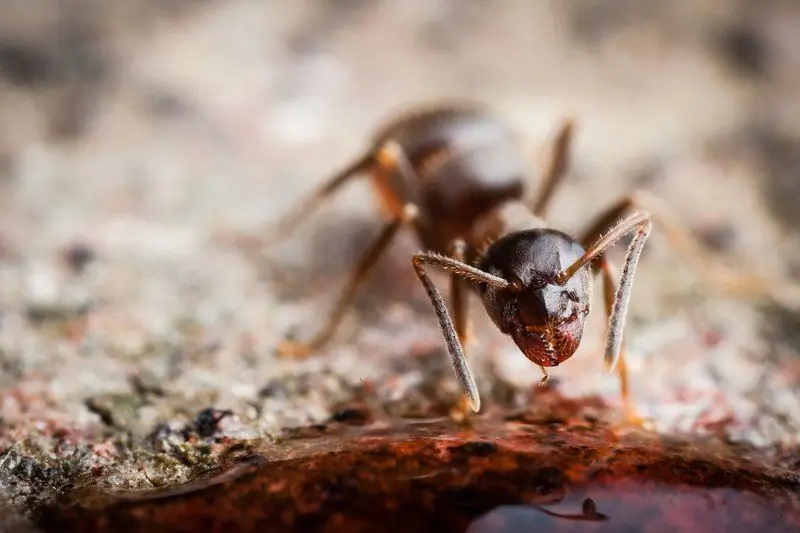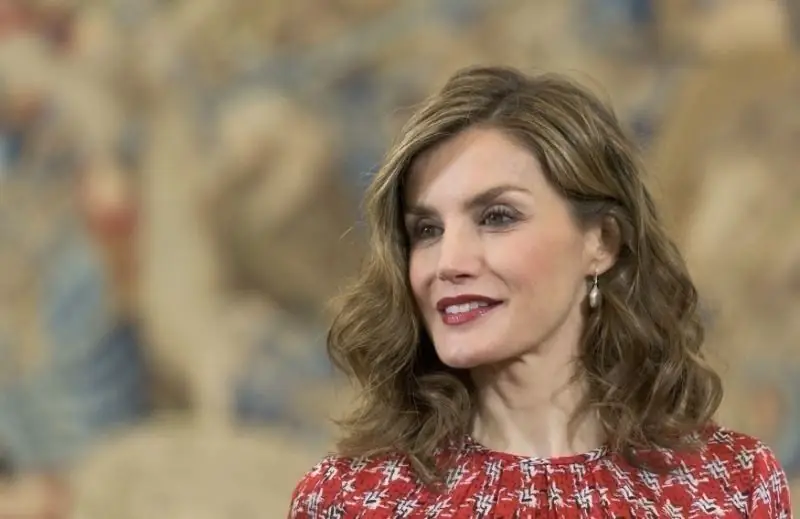
Table of contents:
- Author Bailey Albertson [email protected].
- Public 2023-12-17 12:53.
- Last modified 2025-01-23 12:41.
The main questions about the queen ant: revealing all the cards

An anthill is a small sovereign state with a strict hierarchy. There are simple workers, larvae, courtiers, and they are headed by the queen of the kingdom - the ant queen. It does not run the "state", it has slightly different functions, but the anthill, as a rule, does not live without it.
Content
-
1 The role of the uterus in the anthill
- 1.1 Can an "ordinary" ant become a queen
- 1.2 Is the queen really in charge of the anthill?
- 2 What does an ant queen look like
-
3 The life of the uterus from birth to the foundation of its colony
- 3.1 Parasitizing other colonies
- 3.2 Video: The queen ant lays eggs
-
4 What happens if the uterus dies
4.1 If the uterus died in the incubator
-
5 Where to find a queen to get rid of domestic ants
5.1 Video: how to find and catch a queen ant in nature
The role of the uterus in the anthill
The queen does not work like other ants, does not protect the colony, does not look for building materials or food, it has a more important role to lay eggs. From them, then new individuals appear, which come to the place of ordinary workers. The queen is a special female in the nest that has the ability to lay eggs. There are other females in the colony, but they do not give "offspring", but perform the same functions as other members of the community.

All ants serve the anthill and their queen, without whom they will die
If the colony is very large (mainly in natural conditions), then there may be several queens. This is called polygyny. The queens lay eggs, they are treated in the same way, there is no preference for one queen over another. Therefore, if you decide to destroy the anthill, depriving it of the queen, and the colony for some reason remained in the same place, this means that there are several queens.

In large ant colonies of queens there may be several
Can an "ordinary" ant become a queen
The primitive ant species do not have a queen, but there are several females that can lay eggs. They perform the role of a womb, but live as long as their counterparts. This means that the duration of the genus of this particular colony directly depends on the short life of the females: if all oviparous ants disappear, the anthill will be doomed to death.

A simple worker ant cannot become a queen
An ordinary ant cannot become a queen, he can only temporarily perform her functions, but a colony without a queen is obviously doomed to extinction
Is the queen really in charge of the anthill?
The queen lives in the very depths of the anthill, so other living things, as a rule, cannot get to it, and some natural "disasters" (something fell from above, a strong wind blew - and the ant was carried away, etc.) it is practically not affected. Throughout her life (and this is up to two decades), she only does what she gives offspring. 90 or more generations can change, and the uterus will be alone and will lay eggs as efficiently as in the first time after fertilization. Therefore, of course, the ant queen is the most important, significant unit of the entire kingdom of ants.

Floods and fires are natural disasters that can really destroy the queen ant.
What does an ant queen look like?
It is very simple to distinguish an ant queen from a simple "hard worker": it is larger in size, thicker, if I may say so. The queen has a large abdomen on which the oviparous organ is located (in domestic ants, the abdominal dimensions are 3-4 mm). Also, the queen has a massive chest, which is no less than the head. This is due to the fact that initially, before the breeding period, the female had wings, so the muscles in this area are large and strong.

The ant queen is always larger than "ordinary" ants
The life of the uterus from birth to the foundation of its colony
In colonies, there are always many males and females, but not all "female representatives" are capable of fertilization. Those of them that can give birth to mate with the opposite sex in the summer, after which they either return to the mother colony (if these are red ants), or go in search of a good place to found their settlement. They migrate not so far from the place of their birth and subsequently constantly "keep in touch" with their first anthill.

If an ant was born a female, this does not mean that it will live long and is a queen.
The future queen is looking for a place for her kingdom using wings. After she has decided on the location, the female lays the first eggs and sheds her wings or chews them off. The uterus does not seek food for her offspring, but feeds him either specially laid eggs, or fat reserves and decaying wing muscles.

The uterus itself controls how many and which individuals it will "give birth"
It is rather difficult to say in advance whether a female is a uterus, because this is determined not only by her ability to reproduce, but also by her life expectancy. If she lives longer than an ordinary ant, then she is a queen, if not, then she was not her.
The queen rarely eats herself: there are special "court" ants that chew food beforehand, after which they give it to the queen. Such food is easier and faster to digest, which is exactly what the one on which the well-being of the entire colony depends. She feeds mainly on protein foods.
Parasitizing other colonies
All ants, with the exception of one species, either create their colonies in a new place, or live with their "mother". Only Formicoxenus Nitidulus climbs into a strange anthill and lives there happily. Of course, their "guards" are "enough", but this is where the matter ends. Scientists speculate that Formicoxenus Nitidulus secretes a secret that scares away other ants. The uterus of such parasites can quite easily settle in any other anthill and create its offspring there.

Formicoxenus Nitidulus parasitizes foreign colonies
Video: queen ant lays eggs
What happens if the uterus dies
As practice shows, it is impossible to say unequivocally what will happen if the uterus is destroyed. If she had a brood when you caught her, then the chances are high that the colony will soon die. If she recently laid eggs, then there is a possibility that among the new individuals there will be either a female or a full-fledged uterus, which will continue to give birth to offspring.

If only the queen is left alive, she will revive the anthill, and if only the queen is killed, then there is a high probability that the colony will die
The lifespan of an ant depends on what species it belongs to. If we are talking about domestic (pharaonic) insects, then the male lives only 20 days, and the working individual - 60 days. Therefore, if the uterus did not leave new offspring, then the ants will die in less than 2 months.
If the uterus dies in the incubator
Ants must be properly cared for; they must not be released into the formicarium ahead of time. The smaller the colony and the larger the space for it, the higher the likelihood that ants will carry garbage around the incubator, which will cause mold and other "joys" that will destroy the community and the queen as well. If you followed all the rules for breeding ants, and the uterus died anyway, you must either wait to see if she left another female instead, but in this case the colony may disappear, or acquire a new uterus.

Ants should be bred very carefully and carefully, otherwise it is easy to destroy the entire colony.
Personal experience says that the queen must be of the same species as the entire colony, otherwise the ants will not accept it and kill it.
Where to find a queen to get rid of domestic ants
House ant nests are usually located in secret places. First you need to determine where the insects come from. To do this, you can trace the movement of the worker ants. However, it also happens that there is a network of diffuse nests located in different places, between which a connection is maintained, and the uterus can be located in any of them. In this case, there is very little chance of finding the queen ant.
The queen lives very deep in the anthill so that no enemies can reach it. And it is almost impossible to lure her out. You can try to arrange some kind of small apocalypse so that the instinct of self-preservation works in insects (for example, blow on the ant's nest with a hairdryer or a fan). However, in the stream of ants, it will be difficult to pull out the uterus. Therefore, it is necessary to search in the colony itself and get the queen out of there. In the same way, you need to get the uterus of ants in natural conditions (in nature). It is quite simple to destroy it - insects do not survive in boiling water or under a heavy load.

With aerosols, it is easy to treat vertical or inclined surfaces where ants are hiding
Video: how to find and catch a queen ant in nature
It is not for nothing that the queen of ants is called a queen - she is a mother for the entire colony, and not even for one, because the females born by her create their settlements. If you destroy the entire anthill, but leave the queen, the settlement will soon revive. However, having got rid of only the queen, the entire anthill will die in the coming weeks if there are no females left among the eggs laid. This must be taken into account when spreading your ants and, if you wish, to cleanse your house of uninvited “guests”.
Recommended:
How To Use Alice From Yandex: How To Install A Voice Assistant On A Computer And Phone, What Functions Does It Have

"Alice" from "Yandex" - the main functions, which differs from other voice assistants. How to use "Alice", how to install it on your phone and computer
Far Eastern Forest Cat (Amur): What It Looks Like, Photo, Habitat, Keeping In Captivity

The appearance of the Amur wild cat. Range and lifestyle of the Far Eastern forest cat. The life of an Amur cat in captivity. Conditions of detention and safety
Deprive Cats And Cats (shearing And Other Species): What It Looks Like, Signs, Treatment Of Kittens And Adult Animals At Home, Photo

How does shingle manifest in cats? The causative agent and types of the disease. Features of the course of the disease. Treatment methods and prognosis. Deprivation prevention. Reviews
Where And How Does A Lemon Grow, How A Plant Blooms, Including At Home, What A Leaf Looks Like

Where and how lemon grows and blooms, including in indoor culture and in the garden in the open field
How To Look Like A Queen; Royal Secrets

What you can learn from royals to look their best
